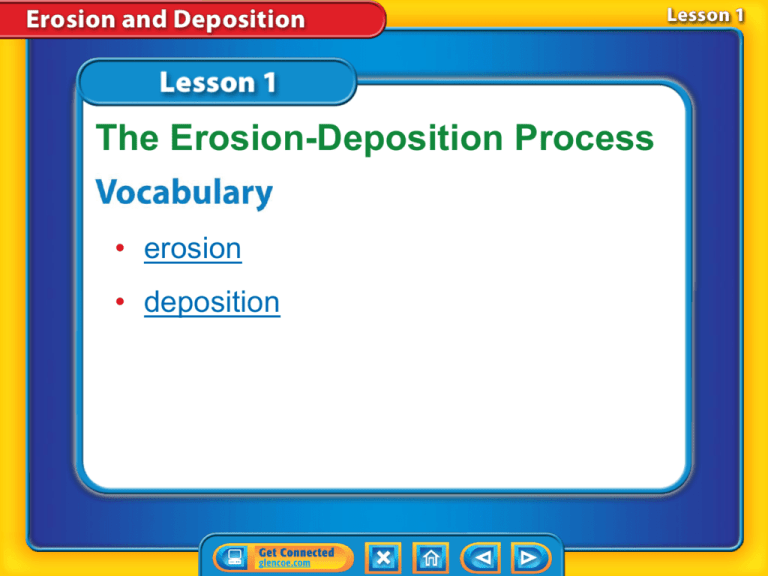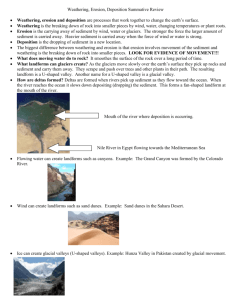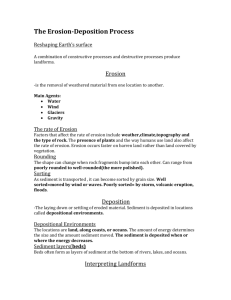File
advertisement

The Erosion-Deposition Process • erosion • deposition Reshaping Earth’s Surface • A combination of constructive processes and destructive processes produce landforms. • Constructive processes build up features on Earth’s surface. • Destructive processes tear down features on Earth’s surface. The breakdown of rock—weathering— is one type of destructive process that changes Earth’s surface. A Continual Process of Change • Chemical weathering alters the chemical composition of rock. • Physical weathering is the breaking of rock into pieces, called sediment, without changing the chemical composition of the rock. • Water, wind, and ice are agents, or causes, of weathering. A Continual Process of Change (cont.) • The mineral composition of some rocks makes them less resistant than others are to weathering. • The difference in the rate of weathering can produce unusual landforms. Erosion • Erosion is the removal of weathered material from one location to another. • Agents of erosion include water, wind, glaciers, and gravity. • Factors that affect the rate of erosion include weather, climate, shape of the land, and type of rock. Erosion (cont.) • The presence of plants and the way humans use the land affect the rate of erosion. • The rate of erosion sometimes depends on the type of rock. • Weathering breaks some types of rock into large pieces. Other rock types easily break into smaller pieces that are more easily transported. Erosion (cont.) As rock fragments bump against each other during erosion, the shapes of the fragments can change. Erosion (cont.) • Erosion also affects the level of sorting— separating of items into groups according to one or more properties—of sediment. • Sediment is often well-sorted when it has been moved a lot by wind or waves. Erosion (cont.) Poorly sorted sediment often results from rapid transportation, perhaps by a storm, a flash flood, or a volcanic eruption. Deposition Deposition is the laying down or settling of eroded material. deposition from French deposer, means “put down” Deposition (cont.) • As water or wind slows down, it has less energy and can hold less sediment, which can result in some of the sediment being deposited. • Sediment is deposited in locations called depositional environments, such as swamps, deltas, beaches, and the ocean floor. Delta Deposition (cont.) • High-energy environments, like rushing rivers and ocean shores with large waves, are those in which sediment is transported and deposited quickly. • Small grains of sediment are often deposited in low-energy environments, like deep lakes, areas of slow-moving air, and swamps. • Sediment deposited in water typically forms layers called beds. Interpreting Landforms • Landforms can have features that are clearly produced by erosion. • Different rates of erosion can create unusual landforms like tall, protruding landforms called hoodoos. • Glacial erosion can produce ice-carved features in mountains. Interpreting Landforms (cont.) • Landforms created by deposition are often flat and low-lying. • An apron of sediment, called an alluvial fan, often forms where a stream flows from a steep, narrow canyon onto a flat plain at the foot of a mountain. Interpreting Landforms (cont.) Deposition along a riverbed occurs where the speed of the water slows down and can result in a sandbar.







